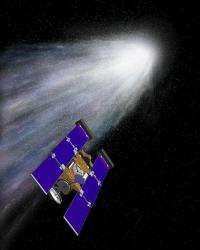Comet-hunting spacecraft shuts down after 12 years

With the click of a mouse, Sandy Freund Kasper sent a command to NASA's comet-hunting Stardust space probe to burn all its fuel, starting a sequence that would shut the spacecraft down after a 12-year run.
"Like saying goodbye to a friend," said Allan Cheuvront, the Stardust program manager for Lockheed Martin, who has worked on the probe since 1996, when it was still in the design stage.
"It's been an amazing spacecraft," he said Thursday. "It's done everything we asked, it's done it perfectly."
Launched in 1999, Stardust finished its main mission in 2006, sending a tiny sample of particles from the Wild 2 comet to Earth via a parachute-equipped canister. NASA then recycled the probe, sending it past a comet last month to photograph a crater left by a projectile launched by another space probe.
It accomplished one last experiment on Thursday, firing its thrusters until its last hydrazine fuel was gone. The length of that burn, a little under 2 1/2 minutes, will tell engineers exactly how much fuel was left so they can see how accurate their calculations were.
That in turn will help with the design and operation of future probes.
It will take a few days to analyze the fuel data, said Jim Neuman, a mission operations manager for Lockheed Martin, which built and operated the probe for NASA.
Freund Kasper was serving as the Stardust "ace" Thursday, sending commands to the spacecraft from a big room in Lockheed Martin's Denver complex that looked more like a set from "The Office" than a 21st century mission control.
A dozen or so engineers peered at computer screens in low-walled cubicles. Tape dispensers, beige telephones and three-ring binders lined the work stations. There was a dollar-a-head office pool, with 60 or so names scrawled on a whiteboard with their best guesses on how much fuel Stardust had left.
Before Freund Kasper sent Stardust its final instruction, Cheuvront polled eight or nine other engineers at work stations labeled "Power," "Thermal," "Propulsion" and other roles, asking each in turn if the probe was ready.
Then he turned to Don Brownlee of the University of Washington, the lead scientist on Stardust's primary mission to take samples from the Wild 2 comet.
"It's been a wonderful and overwhelming experience," Brownlee said.
At 4:41 p.m. MDT, Freund Kasper sent a command instructing Stardust to begin executing a set of instructions that had been transmitted to the probe earlier in the day.
About 42 minutes later - the time it took the command to travel the roughly 93 million miles to Stardust, and for Stardust's reply to reach Earth - the engineers' computer screens showed the burn was under way.
Once the fuel was gone, Stardust lost its ability to keep its antennas pointed toward Earth, and the control room lost radio contact at 5:33 p.m.
If the probe executed all of its final orders as expected, it put itself in "safe mode," turning most of its systems off, at 6:13 p.m., about 1 1/2 hours after the last command was sent.
With no fuel, Stardust can't keep its solar panels aimed at the sun, and once its batteries are drained it will shut down for good.
Stardust will be left in an orbit around the sun. Engineers project that in the next 100 years, Stardust won't get any closer than 1.7 million miles of Earth's orbit or 13 million miles of Mars' orbit.
More information: http://stardustnext.jpl.nasa.gov/
©2010 The Associated Press. All rights reserved. This material may not be published, broadcast, rewritten or redistributed.
















